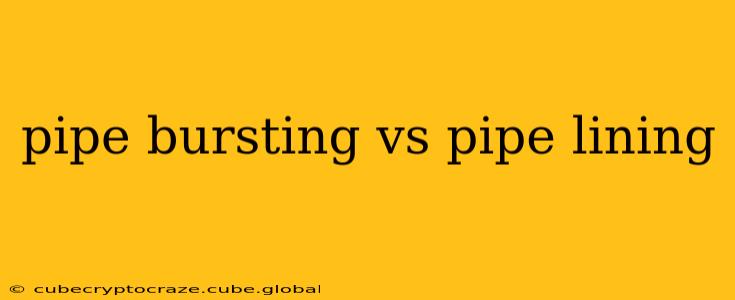Choosing between pipe bursting and pipe lining can be a crucial decision for homeowners and businesses facing aging or damaged water and sewer lines. Both methods offer trenchless solutions, minimizing disruption to your property, but they differ significantly in their approach and suitability for various situations. This comprehensive guide will delve into the key distinctions between pipe bursting and pipe lining, helping you make an informed choice.
What is Pipe Bursting?
Pipe bursting is a trenchless technology used to replace existing underground pipes. A specialized bursting head is pulled through the old pipe, shattering it into smaller pieces while simultaneously pulling in a new, stronger pipe of the same or larger diameter. This process effectively creates a new pipeline in the same trench as the old one, eliminating the need for extensive excavation.
Key Advantages of Pipe Bursting:
- Increased Diameter: Allows for upgrading to a larger diameter pipe, improving flow capacity.
- Strength and Durability: The new pipe is typically made of high-density polyethylene (HDPE), a very strong and long-lasting material.
- Minimal Disruption: A trenchless method, reducing surface damage and landscaping disruption.
- Suitable for Difficult Access: Can be used in areas with limited access or challenging soil conditions.
Key Disadvantages of Pipe Bursting:
- Higher Initial Cost: Generally more expensive upfront than pipe lining.
- Not Suitable for All Pipes: May not be feasible for severely collapsed or severely deteriorated pipes.
- Potential for Debris: The bursting process can create debris that needs to be managed.
What is Pipe Lining?
Pipe lining, also known as cured-in-place pipe (CIPP) lining, involves inserting a flexible liner into the existing pipe. This liner is then inflated and cured (either using hot water or UV light) to create a new pipe within the old one. The cured liner adheres to the existing pipe, forming a smooth, seamless interior.
Key Advantages of Pipe Lining:
- Lower Initial Cost: Typically less expensive than pipe bursting, especially for smaller diameter pipes.
- Less Disruptive: A highly minimally invasive process, requiring only small access points.
- Suitable for a Wider Range of Pipe Materials: Can be used with various pipe materials, including clay, cast iron, and PVC.
- Fast Installation: Relatively quick installation time compared to traditional excavation methods.
Key Disadvantages of Pipe Lining:
- Limited Diameter Increase: Does not usually allow for increasing the pipe diameter.
- Shorter Lifespan Compared to Bursting (Sometimes): While the liner itself can be durable, it's dependent on the condition of the existing pipe.
- Not Suitable for Severely Damaged Pipes: May not be suitable if the existing pipe is heavily damaged or collapsed.
Pipe Bursting vs. Pipe Lining: Which is Best for Me?
The best choice depends on several factors, including:
- The condition of the existing pipe: Severely damaged pipes may require bursting, while pipes with minor cracks or corrosion might be suitable for lining.
- The required diameter: If you need to increase the pipe diameter, bursting is the only option.
- Your budget: Pipe lining is generally less expensive upfront, while pipe bursting offers long-term cost savings due to its increased durability.
- Accessibility: Both are trenchless options, but bursting may be preferable in areas with limited access.
What are the different types of pipe lining?
There are several types of pipe lining, each with its own advantages and disadvantages. These include:
- Cured-in-Place Pipe (CIPP): This is the most common type of pipe lining, using a flexible liner that is cured in place.
- Spray-in-Place Pipe (SIPP): This method uses a spray-applied epoxy resin to create a new pipe inside the existing one.
- Sliplining: This involves inserting a new pipe directly inside the existing pipe.
How long does pipe bursting and pipe lining last?
The lifespan of both pipe bursting and pipe lining depends on several factors, including the quality of materials used, the condition of the existing pipe, and soil conditions. Generally, HDPE pipes installed via bursting can last for 50 years or more, while pipe linings can last for 25-50 years, depending on the liner type and condition of the host pipe.
What are the costs associated with pipe bursting and pipe lining?
Costs vary widely depending on factors such as the length of the pipe, diameter, accessibility, and location. It's best to obtain multiple quotes from reputable contractors to accurately assess the cost for your specific project.
By carefully weighing these factors and consulting with a qualified professional, you can select the trenchless pipe repair method that best meets your needs and budget. Remember, a professional assessment of your existing piping system is crucial for determining the most appropriate solution.
